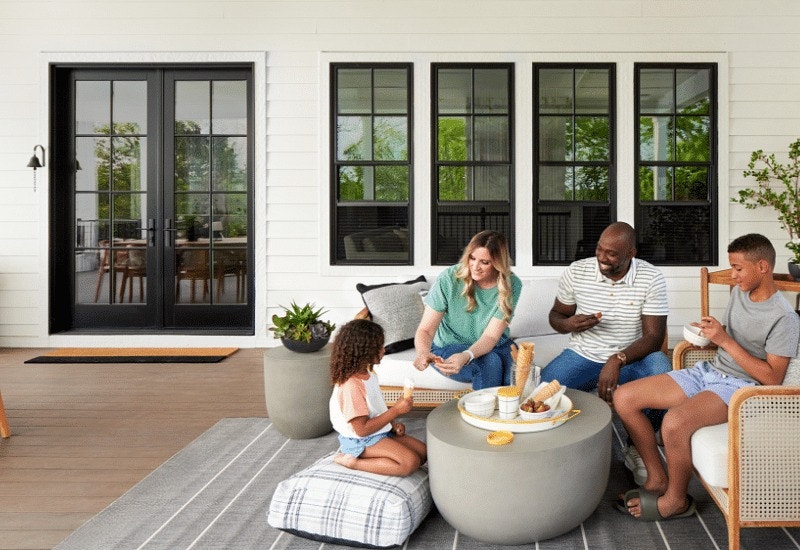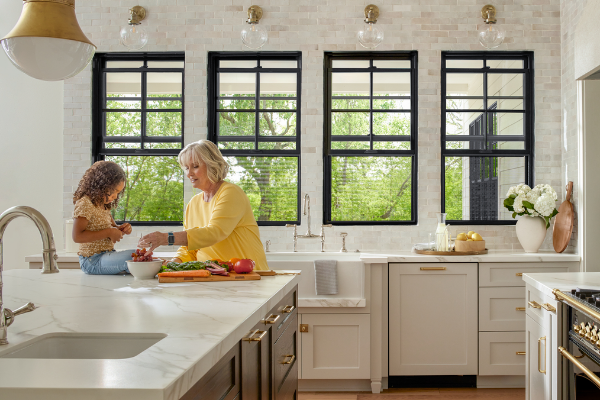How Energy Efficient Windows Can Save You Money
Posted
on June 1, 2020

When it comes to making your home more energy efficient, it can be easy to overlook the impact your windows have on energy usage. Drafty windows are a more apparent source of air leakage, but you don’t need to wait for there to be an obvious issue before opting for window replacements. The right windows can help you save energy when it comes to heating and cooling your home, along with keeping your family more comfortable.
The glass in your windows can increase energy efficiency thanks to innovative technologies. And that doesn’t just mean tinting your windows. Multiple-pane window choices, various types of glazing, gas fills, and even the method used to install the glass can impact your energy bills, regardless of the season.
How Energy-Efficient Windows Save Money
Spending money to save money might seem counterintuitive, but there are many reasons to upgrade your windows before they show signs of failure whether a replacement or new construction, understanding how to save money on windows that are energy efficient is an important piece of the buying process.
Choosing new, energy-efficient windows can help save you money in several ways and help you realize benefits beyond the monetary savings.
- Lower heating and cooling costs
- Qualification for ENERGY STAR ratings and incentives
- Reduced reliance on artificial heating and cooling
- Increased comfort within your home
- Enhanced style and operability
But how do you make sure that the windows you’re choosing are energy efficient? Some of the main techniques used to make windows energy efficient are:
- Number of panes of glass
- Glazing or coatings
- Gas-filled windows
- Construction of the frame and edge spacers
- Proper window installation to prevent air infiltration
- Window frame material
It’s important to understand these differences to adequately compare and contrast your options.
Understanding ENERGY STAR® Ratings
When choosing windows for their energy efficiency, it's important to first research energy-performance ratings in relation to the local climate and your home's design. What does “energy efficiency” really mean and how can you compare the energy savings of one window against another?
ENERGY STAR is a government-backed trademark that provides consumers with a reliable source for energy efficiency information on home products. When shopping for an energy-efficient window, search for the ENERGY STAR label. It will show several factors that go into identifying performance so that you can compare styles, brands, and materials to find one that suits your needs. ENERGY STAR windows, meaning those featuring an ENERGY STAR label, have met or exceeded the necessary qualifications for energy efficiency performance.

Window energy performance ratings scales
- Window U-Factor: The rate of heat loss to the outside. A low U-factor is better.
- Solar Heat Gain Coefficient (SHGC): Normally listed as a fraction, this is the amount of solar radiation that a window lets in. SHGC is measured on a scale from 0 to 1. Window SHGC typically ranges from 0.25 to 0.80. Again, a low number is better.
- Air Leakage (AL): The rate at which air passes through the joints in the window. The lower the AL value, the less air leakage.
- Visible Transmittance (VT): The amount of light the window lets through measured on a scale of 0 to 1, with values generally ranging from 0.20 to 0.80. The higher the VT, the more light you see.
- Condensation Resistance Factor (CRF): This measures how consistently the window resists water buildup on a scale from 0 to 100. The higher the CRF, the better the window will guard against condensation.
SEE ALSO: What Are Energy-Efficient Windows
PRO TIP
Make sure to look for scores based on whole-unit numbers as opposed to center-of-glass numbers (COG). Whole-unit numbers are more trustworthy indicators of the window’s overall performance, while COG numbers may not be as consistently reliable in areas of the window farther away from the center.
Multiple panes of glass can help maintain climate control
Generally, the more panes of glass in a window, the more energy efficient it will be. Double-pane windows, for example, are an attractive option for homeowners looking to save on their energy bills. The space between the two layers of glass can provide more effective insulation, keeping the cold out in the winter and retaining more heat in the summer.
While they can cost more, triple-pane windows will offer even greater energy efficiency. Adding a middle pane means greater protection against the elements and allows the inner pane of the window to stay closer to room temperature. A third pane also cuts down any convection currents and drafts that could make a room’s temperature fluctuate.
Beyond improving energy efficiency, triple-pane windows also provide greater protection against sound and break-in damage than double-pane replacement windows. So, if you have loud neighbors or live in a busy or noisy area, consider the benefits of triple-pane windows.
Increase energy efficiency with glazing
The glazing on your windows can have an impact on reducing both the SHGC (Solar Heat Gain Coefficient) and VT (Visible Transmittance) that determine ENERGY STAR ratings. In other words, glazing helps control the amount of light and sun rays allowed in. For years, many people have used tinted glazing to block sunlight and reduce glare. But two other techniques can help on both sides of the glass and improve energy efficiency in your home.
For windows with two or more panes of glass, insulated glazing is created when the glass panes are spaced apart and hermetically sealed, leaving an insulating air space. Insulated window glazing predominantly lowers the window U-factor, but it also improves the SHGC.
Low-e coating can also influence energy efficiency. A microscopically thin, nearly invisible metal or metallic oxide layer added directly on the surface of one or more of the panes of glass, Low-E coating helps lower the window U-factor and can decrease energy loss by as much as 30 to 50 percent.
Keep your home insulated with gas-filled windows
Gas-filled windows made of at least two panes of glass with either argon or krypton gas filling the space between each one are becoming increasingly common these days. The gas creates another invisible barrier against the heat and cold that would impact a window’s U-factor or leakage rate.
Argon and krypton are nontoxic, naturally occurring gasses found in the air we breathe. Factory sealing the gas between the window’s glazing layers reduces the possibility of leakage or condensation buildup on the interior and exterior of your windows.
Edge spacers can help seal out leaks
The last factor that helps improve your window’s energy efficiency is the edge spacer. Edge spacers serve many functions.
- Bear the stress the window faces with expansion and contraction during times of heat and cold.
- Provide a moisture barrier to prevent water or vapor condensation.
- Provide a gas-tight defense that prevents the loss of any gas in Low-E windows.
Windows are available in single-seal or double-seal systems. Aluminum seals are most common because of the material’s strong energy-conducting traits.
Single-seal systems include an organic sealant applied behind the spacers that holds the unit together and prevents moisture leakage. A double-seal system adds a secondary backing sealant, often silicon, to further defend against leaks. Double-seal systems are most often seen in Low-E windows to prevent any of the sealed gasses from escaping.
Increase energy efficiency with new windows
There’s a lot of science that goes into developing an energy-efficient replacement window. But, by knowing the basics of what goes into the ENERGY STAR rating and understanding the differences in window glass options, you can discover windows that will make your home temperate and save you money at the same time.
Learn more about energy efficiency in your windows by talking to our professionals at Pella. You can schedule a free in-home consultation and get customized advice for your home.
Schedule a free consultation to find windows and doors for your home.
